Читать книгу Medical Statistics - David Machin - Страница 119
4.10 Exercises
Оглавление1 4.1 Which ONE of the following statements about probability is INCORRECT?If two binary outcomes (X and Y) are mutually exclusive the probability that either X or Y occurs is the sum of the probability that X occurs and the probability that Y occurs.If two binary outcomes (X and Y) are independent, then the probability that both outcomes X and Y occur is the probability that X occurs multiplied by the probability that Y occurs.When the outcome will definitely happen the probability of it happening is 1.When an outcome can never happen, the probability of it happening is 1.All probabilities range between 0 to 1.
2 4.2 Suppose we toss a single unbiased two‐sided coin three times in a row and record the number of heads. What is the probability of observing a head on three successive tosses?0.5000.2500.7500.1250.050
3 4.3 Suppose we roll a 10‐sided die (numbered 1 to 10) once.What is the probability of observing a score of 6 or more on this roll?0.40.50.60.70.08
4 4.4 Which ONE of the following statements about the Normal distribution is INCORRECT?The Normal distribution is symmetrical.The peak of the curve lies above the mean.The total area under the Normal distribution curve is 1.The mean and median will coincide.The bigger the variance the taller the peak.
5 4.5 Which (if any) of the following statements about the Normal distribution is CORRECT?Approximately 1% of the observations from a Normal distribution lie outside the mean ± 2SD. Approximately 2% of the observations from a Normal distribution lie outside the mean ± 2SD.Approximately 3% of the observations from a Normal distribution lie outside the mean ± 2SD.Approximately 5% of the observations from a Normal distribution lie outside the mean ± 2SD.Approximately 10% of the observations from a Normal distribution lie outside the mean ± 2SD
6 4.6 Which (if any) of the following statements about the Normal distribution is CORRECT?Approximately 1% of the observations from a Normal distribution lie outside the mean ± 1SD.Approximately 5% of the observations from a Normal distribution lie outside the mean ± 1SD.Approximately 10% of the observations from a Normal distribution lie outside the mean ± 1SD.Approximately 32% of the observations from a Normal distribution lie outside the mean ± 1SD.Approximately 95% of the observations from a Normal distribution lie outside the mean ± 1SD
7 4.7 The systolic blood pressure in the population of middle‐aged people is Normally distributed with a mean of 140 mmHg and a standard deviation of 10.What is the approximate probability of having a systolic blood pressure of 120 mmHg or less?0.0250.050.160.320.95What proportion of the population of middle‐aged people have a systolic blood pressure between 130 and 150 mmHg?0.950.680.320.160.90
8 4.8 The birthweight of babies in the population is Normally distributed with a mean of 3.5 kg and a standard deviation of 0.5 kg.What is the probability of giving birth to a baby weighing more than 3.5 kg?0.0250.050.50.750.95What is the approximate probability of giving birth to a baby weighing more than 4.0 kg?0.0250.050.160.320.95What is the approximate probability of giving birth to a baby weighing more than 4.5 kg?0.0250.05 0.160.32 0.95
